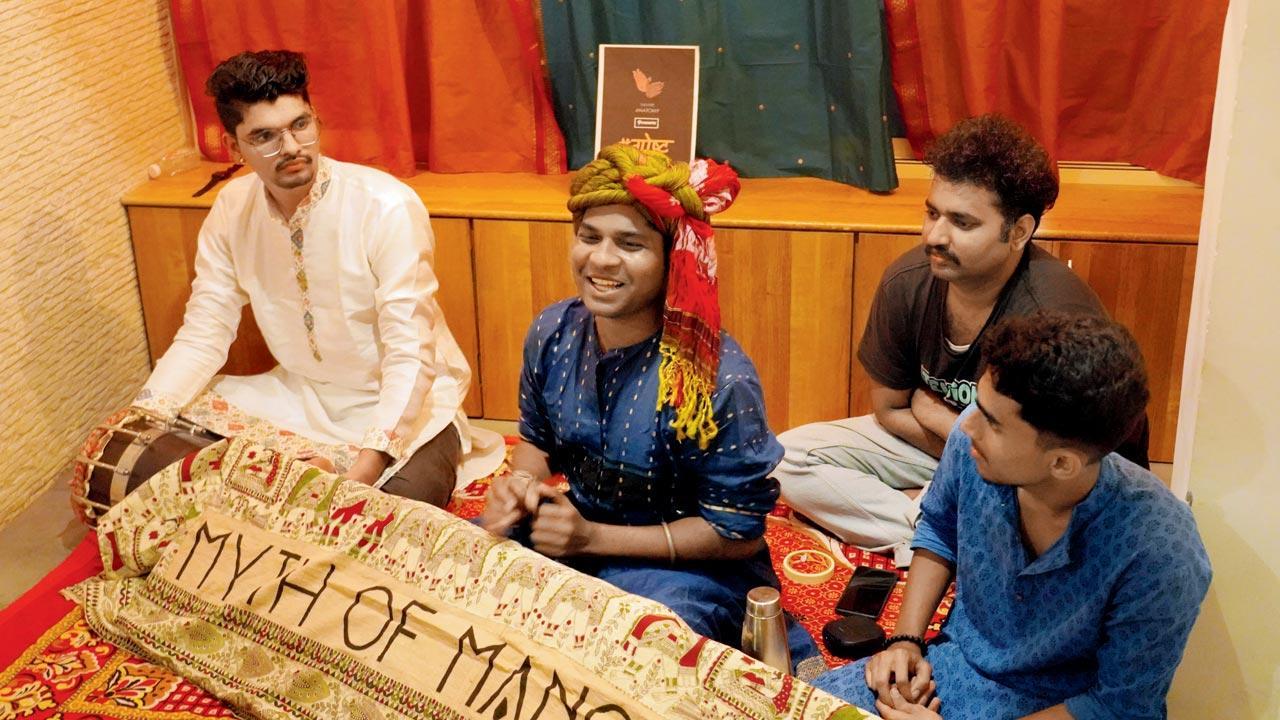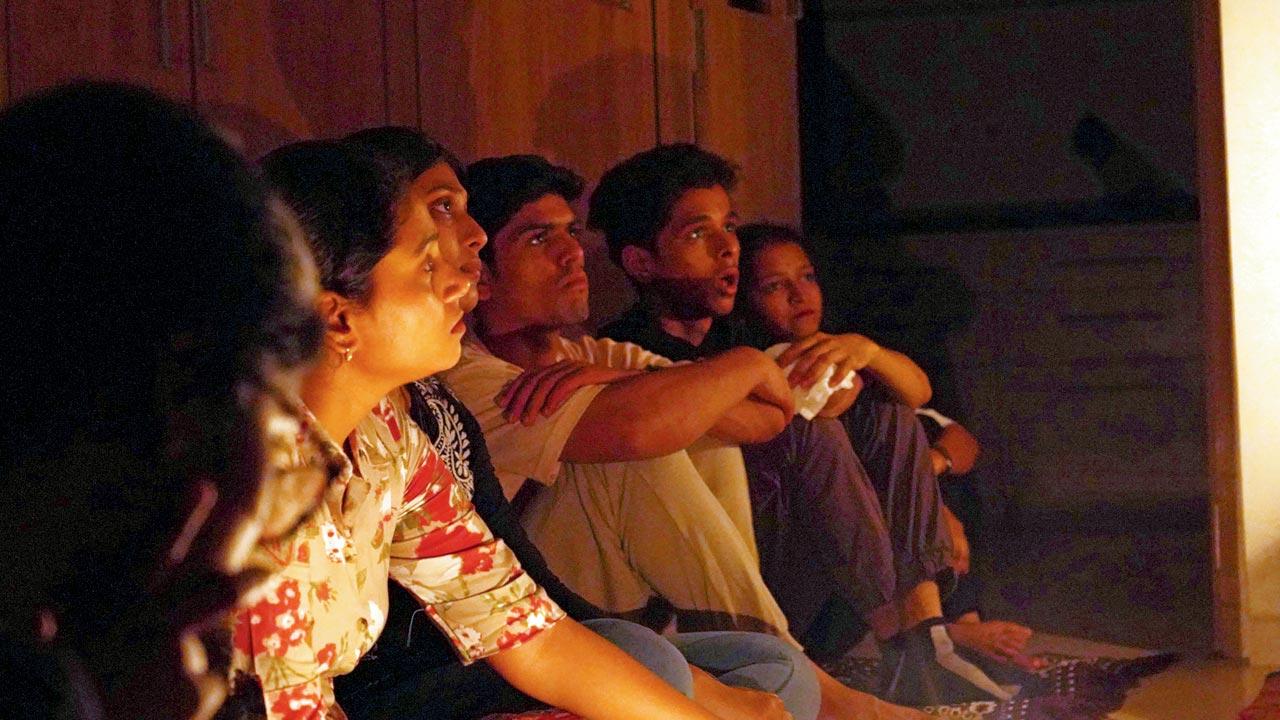As a multilingual play on gender justice unfolds at a flat in Kalwa, the audience meets five sea princesses who were denied freedom of choice

Theatre Anatomy group artistes perform the Myth of Mandigoes
![]() Social distancing is the buzz word in COVID times, but not so for Theatre Anatomy. The fledgling group of 20-something fine artists, writers and theatre art practitioners stand up, close and personal with their audience, notwithstanding the pandemic protocols. The group discards the box set proscenium in favour of flexible informal spaces. Their last performance in a flat in Kalwa was the 46th show of the 45 minute-long Myth of Mandigoes.
Social distancing is the buzz word in COVID times, but not so for Theatre Anatomy. The fledgling group of 20-something fine artists, writers and theatre art practitioners stand up, close and personal with their audience, notwithstanding the pandemic protocols. The group discards the box set proscenium in favour of flexible informal spaces. Their last performance in a flat in Kalwa was the 46th show of the 45 minute-long Myth of Mandigoes.
ADVERTISEMENT
In the last two years, the play was presented in patrons’ homes, terraces, chawl corridors, gyms, cafes, community halls—one in a Buddha Vihar in Ghatkopar—and only four times in auditoriums. The next two shows will be in Pune and Ratnagiri in two friends’ residences.
“For as long as we have the roof—literally speaking—over our heads, our shows will continue. We don’t need to fear the upcoming monsoon. We can perform in
any small or big-sized home space, irrespective of the number of people watching us; even a single patron works, and a roomful is welcome too,” says Shantanu Sayali, 22, the playwright, who is a student of Lalit Kala Kendra Gurukul, University of Pune.
 A mixed-bag audience of adults, children and elderly attended the recent showing at a flat in Kalwa
A mixed-bag audience of adults, children and elderly attended the recent showing at a flat in Kalwa
Before relocating to Pune, he schooled in Ratnagiri, which explains his choice of the Chitrakathi form—narration aided by paintings, indigenous to Konkan—for presenting Myth of Mandigoes. Sayali begins the play with the customary “garhane” in Malvani, invoking the deities to resolve the issues at hand. He complements Malvani with Marathi, Hindi, English, and a bit of Urdu too. The language mix suits the informality in the folk framework and makes ample room for pop-culture references—Harry Potter’s broom, PM Modi’s bullet train, Shah Rukh-Kajol’s violin act and Bahubali’s antics; ‘hashtag’ Karan Johar trends throughout the filmy portions of the narrative.
“We don’t mind adapting to or roping in any language which helps in underscoring our central idea—freedom of choice is a birthright and no girl/woman can be forced into an ‘alliance’; no human can be killed for saving someone else’s honour,” adds Sayali, who also played the lead sutradhar of the play. But life’s responsibilities preceded theatre, and Sachin Veer, also a theatre student from Ratnagiri, now a Mumbaikar, took on the lead role.
The show currently rests on Veer’s solo act, supplemented by vocalist Vinay Kesarkar, dholaki player Yash Khade, not to forget the guided tour of Mandigoes facilitated by Rohit Mestry’s paintings. Mestry, the alumna of Sir JJ School of Art, contributes mightily in the visualisation of the colourful, aquatic universe. “It’s a journey to an unfamiliar land without human presence. It is my tool to reflect on human prejudices and illogical behaviour in a setting that suspends disbelief. People get the message faster, because they enter the magical setting with no guards on,” says Sayali.
The Myth of Mandigoes shuttles from one princess to the other; each story starting with hope and romance, but ending with separation and censure. Suri falls for guppy fish, Saroni woos starfish, Surmayee romances ocean waves, Sanjoli vibes with a stone, and Sobita vies for sun rays. None of the five daughters of King Trevol are able to unite with the person of their choice; either the caste differs or the gotra and kul doesn’t match, or the stature does not align.
In short, the king, an otherwise adarsh raja, silences his young girls, and even hangs one of them for daring to dream, as that suits his strategic needs.
The script involves the audience from the beginning. The “sutradhar” asks patrons to adapt the seating as per the space available. Usually, a recce of the home space is not possible, so last-minute decisions are imminent.
For instance, the drawing room in Kalwa (20 ft by 10 ft) of arts curator and founder of Riwaaz Music Foundation Mehul Nayak accommodated over 40 adults and five children. The dividing line between the audience and the performers was blurred. Despite the strict warning against mobile phone usage, two senior citizens excused themselves to the adjacent kitchen for urgent work when the play reached the climax. Children were generally quiet, but restless because of the dim lighting; late entrants stood in the alley throughout the play. The deep fried wadas in the kitchen waged an olfactory assault on the audience and performers alike, raising hope of a post-show gourmet prep. The voluntary donations—cash collected in an upturned hat—after the show were sizeable, informed manager Chaitanya Desai.
A home in the city like Mumbai is a dynamic place where a bell can ring at any hour; the laundry guy could arrive at an unusual time, and the society watchman could suddenly drop the water cut notice. It is a venue where background noise/sound control is not always possible. The Myth of Mandigoes negotiates these variables in classic theatrical style. In the Kalwa show, the lead performer used light banter to counter commotion in the audience. He called out those who murmured or played with the props.
As the lore goes, a pet cat once came close to the performers of the play; in another show a patriarch started singing with the cast; a member of the audience shared his heartbreak in yet another instance. “Impromptu repartee and exchanges extend our time commitment. But we don’t mind it, since our show goes on,” says lead actor Veer, whose popular refrain “filmy hain par hame accha lagta hain” evokes sure-fire laughter in all shows alike.
Different theatre groups and individuals have staged play scripts in living rooms and other intimate spaces over the years. Some experiments were executed in deserted homes, abandoned havelis, heritage forts and unused basements. In Mumbai, theatre has flourished on different terraces: Kulsum and Walchand to name a few. Satyadev Dubey-directed play Andha Yug opened on the terrace of the building where theatre icon Ibrahim Alkazi lived. Mumbai’s Marathi experimental theatre first flourished in Dadar’s Chhabildas School in the ’70s, and later, in a classroom of a municipal school in Mahim where the Awishkar group was allowed (2005) after-hours theatre. A 230 sq feet garage in Khar recently served as a performance studio for long.
In what can be seen as a milestone in the history of plays performed in lived homes, an one-hour solo act (1988) presented by renowned writer-actor Madhuri Purandare is defining. Purandare presented Abd Abd, a Marathi rendering of the French monodrama La voix humaine. It was a telephone conversation of a dejected woman with her lover—on the other invisible end of the landline—who is soon to marry another woman. Purandare staged it in around 28 homes in Pune, Solapur and Mumbai; each time evoking a heartfelt response. Almost 35 years after she mounted Abd Abd, Purandare still recalls it as a fulfilling experience. “Each home presented itself as a unique set for the play, which was such a rewarding moment. The only constant on all the sets was the telephone instrument. As I played the protagonist, the audience surrounded me from three sides, which diminished the distance between me and the viewers.”
Theatre in a home indeed eliminates boundaries between the audience and the performer. It doesn’t allow the luxury of a mounted stage with a backstage. It has no earmarked green rooms or passage wings.
But in the aftermath of the COVID-19 crisis in which conventional auditoriums are beyond reach, the home offers as an adaptable, collapsible and affordable space. It is a low-cost option, but a high-energy platform that can save the theatre arts from dying. The Myth of Mandigoes brings home the untapped potential of our homes.
Sumedha Raikar-Mhatre is a culture columnist in search of the sub-text. You can reach her at sumedha.raikar@mid-day.com
 Subscribe today by clicking the link and stay updated with the latest news!" Click here!
Subscribe today by clicking the link and stay updated with the latest news!" Click here!







